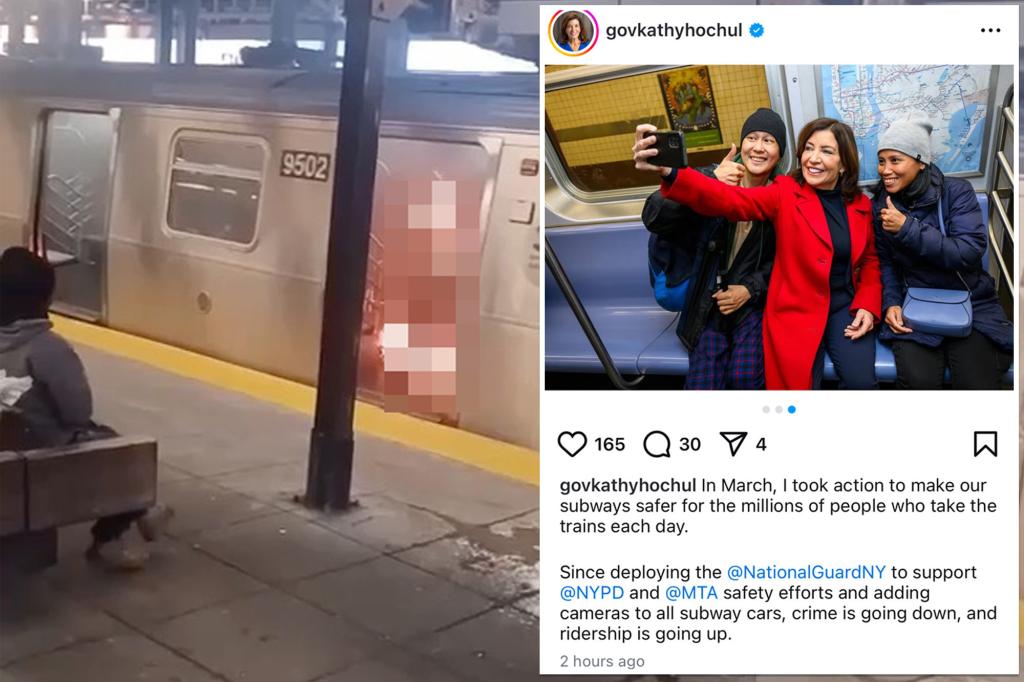New York Governor Kathy Hochul faced severe criticism for a tweet perceived as profoundly insensitive, published just hours after a tragic subway fire claimed the life of a sleeping passenger. The incident, which occurred on a Brooklyn train, highlighted ongoing safety concerns in the city’s transit system. The governor’s tweet, intended to showcase recent improvements in subway safety statistics, was met with outrage from both Democrats and Republicans, who condemned its timing and tone in the wake of the horrific event and a separate double stabbing on a Queens train that left another rider dead. The juxtaposition of the governor’s self-congratulatory message with the grim reality of continued violence on the subway sparked accusations of being out of touch with the concerns of New Yorkers.
Hochul’s tweet, posted on X (formerly Twitter), highlighted a decrease in subway crime and an increase in ridership, attributing these positive trends to the deployment of the National Guard, increased police presence, and the installation of security cameras in subway cars. However, critics argued that these measures, while potentially contributing to overall improvements, failed to prevent the specific incidents that tragically unfolded over the weekend. Rep. Ritchie Torres, a fellow Democrat and potential gubernatorial challenger, sharply criticized Hochul’s message, labeling her the “most tone-deaf Governor in the history of New York.” Torres emphasized the stark contrast between the governor’s celebratory tone and the brutal reality of the subway fire and stabbing incidents, questioning her grasp of the situation.
Councilman Robert Holden, another Democrat, echoed Torres’s sentiment, describing the timing of Hochul’s tweet as “incredible” and directly linking the governor’s alleged incompetence to the loss of life. The criticism was not limited to Hochul’s own party. Republicans joined in the condemnation, with Rep. Nicole Malliotakis expressing disbelief at the governor’s decision to post such a message in the immediate aftermath of the violent incidents. The bipartisan backlash underscored the widespread perception that Hochul’s tweet was not only insensitive but also demonstrated a disconnect from the anxieties and fears of subway riders.
The two fatal incidents occurred within hours of each other, further intensifying the public’s sense of unease. The first incident, a double stabbing on a 7 train in Queens, resulted in the death of a 37-year-old man and injuries to a 26-year-old man. Police reported that the stabbing stemmed from a dispute with another rider, who was subsequently taken into custody as a person of interest. The second incident, the horrific burning of a sleeping passenger on an F train in Brooklyn, shocked the city. A Guatemalan migrant was arrested in connection with the attack, which left the victim dead at the scene. These back-to-back tragedies highlighted the vulnerability of subway riders and the ongoing challenges facing the city’s transit system.
The governor’s office initially remained silent in response to the mounting criticism surrounding the tweet. However, later in the evening, Hochul appeared to address the public outcry, acknowledging that any crime in the subway system is “one too many.” She emphasized the role of newly installed security cameras in assisting law enforcement in identifying and apprehending the suspect in the F train fire. Furthermore, she reiterated her commitment to increasing personnel and resources to enhance subway safety. While these statements attempted to address the concerns raised, they did little to quell the criticism stemming from the initial tweet, which was widely viewed as insensitive and poorly timed.
The incident underscores the delicate balance between highlighting progress in public safety and acknowledging the ongoing challenges that remain. Hochul’s tweet, while perhaps intended to showcase positive developments, ultimately backfired due to its perceived insensitivity and lack of acknowledgment of the recent tragedies. The incident serves as a cautionary tale for public officials about the importance of carefully considering the timing and tone of their communications, particularly in the wake of tragic events. The widespread criticism highlights the public’s expectation for empathy and responsiveness from their elected officials, especially when dealing with sensitive issues such as public safety.

